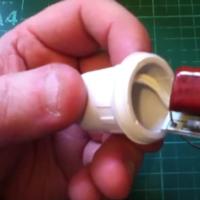How to close pipes and radiators with plasterboard. How to close radiators and pipes with drywall How to close a radiator in a room with drywall
Coming home again and looking around the room, his eyes stopped at the ugly cast-iron ribs of the battery, which had already peeled off and instead of white they had acquired a dirty gray tint.
I decided not to postpone this problem for a long time and began to think how to do it.
Someone will think that making screens for radiators on their own is an extra chore. After all, you can buy a decorative headband and thus solve the problem. But not always finished products are suitable for your battery. Two metal screens hung at my house for a long time, and still one stuck out to the side, since the size was not quite suitable for radiators.
Making screens for batteries is not such a difficult thing, the design is quite simple. You can install it yourself, it will be inexpensive. Most suitable material- It's drywall. It is easy to use, easy to cut and cut. In addition, all the necessary connecting elements are on sale at any hardware store. Also, complex construction tools are not needed, usually they are available in the house.
Material preparation
Since drywall is still a material that is subject to drying under the influence of temperature, it must first be prepared.
Preparation will consist in processing drywall with PVA glue on both sides. This will fix the material, will not allow it to crack and dry out.
It would be better to paint such a prepared surface or glue wallpaper on it.
Frame formation
Finishing
After the box is assembled, all seams are sealed, the corners are reinforced with corners, mesh and putty. Putty is applied, then a corner is attached, a mesh, then putty again. After drying, the surface is rubbed with sandpaper. The final step will be painting or wallpapering your screen.
In some apartments, it may be more expedient not to install a screen, but to completely close the radiator with pipes with a plasterboard false wall.
Watch the video on how to install such a false wall
It is not necessary to do it yourself Installing the screen on the battery can be done to order, but it can only be yours.
Perhaps a purchased screen will not fit well into your interior, and a plasterboard screen will form a single whole.
Everyone who came across a repair wondered what to do with a heating battery. In many ways, these places of the premises look a little unaesthetic, due to the presence of cast iron. Which are painted with several layers of paint, and that, in turn, begins to crack and spoils the look even more. You can, of course, peel off all the layers of paint and, and even in a different color, let's say under gold, and say that it was so conceived. But then what about the wallpaper that needs to be glued on the back of the battery, and which eventually move away, and all this does not look very worthy.
Actually there is a way out! It is necessary to do that will cover the entire problem area from the floor to the windowsill from the eyes. This solution to the problem has a huge advantage. As a result, it will be very beautiful, including due to the presence of an overhead grille, which I recommend to match with the color of the furniture.
For installation you will need the following tools:
- perforator with 6 mm drill
- screwdriver
- metal scissors
- straight level
- tape measure and pencil
- utility knife with interchangeable blades
- stapler
You will also need the following materials:
- drywall 12 mm
- profile 60x27
- profile 27x28
- sickle
- perforated corner
- self-tapping screws for drywall and metal
- dowel-nails 6x40
Box installation
There is one condition for mounting the box: it is necessary that the window sill protrude at least 3 cm beyond the battery. In my example, the window sill turned out to be small, and I had to. It was not difficult to do this, he kept on the mounting foam. Cut out the new window sill to the desired size and insert it under the window frame. Under it, you need to put chopsticks according to the level that you put on top of the windowsill. Next, fill in the empty space between the window sill and the base. mounting foam. From above, press the load as in the photo below. After three hours, remove the load and proceed with the installation of the box.
The next step is the installation of the frame from the profile. Profile 27x28 must be installed on all adjoining: walls, floor, window sill. Pressing the profile to the base with one hand, make a hole at the same time in it and in the wall with a perforator. Install a 6x40 dowel in the resulting hole and tighten with a screwdriver. A profile 27x28 is also screwed to the bottom of the window sill, only on metal screws, the length of which should not exceed the thickness of the window sill. After that, install jumpers from the 60x27 profile.

Around the battery, decide on the size of the future decorative grille. This place should be made slightly smaller than the grid. There are three main standard sizes gratings: 60x60, 60x90, 60x120. These dimensions are optimal for apartment renovation, and I recommend focusing on them.

The frame is ready and proceed to the installation of drywall. Drywall is cut with a clerical knife with replaceable blades. You can find out more about how to cut drywall. Drywall is screwed with a screwdriver and nothing else. You can put a cross bit on a drill, but this is not very convenient. Therefore, I strongly recommend buying a screwdriver, but not cheap " bullshit“, but Makita or Bosch. Such a tool will serve you for the rest of your life, it is not for nothing that window companies use these brands exclusively. And so that the price of this tool will pleasantly please you, return part of the money spent,. The cost will drop by 2 times!!!

After the entire frame of the box is sewn up with drywall, proceed with the installation. They are fixed in the corners with a stapler, or you can immediately glue them onto gypsum plaster. Put a sickle on all the seams of the drywall box and coat it as well gypsum plaster. Before wallpapering, the box must be puttied, sanded and smeared with a deep penetration primer.
Good luck with the repair!
Modern interior design offers many solutions that will make the house more beautiful and comfortable, but, unfortunately, the cast-iron batteries familiar to everyone hardly fit into current trends, so the problem arises: how to close the radiator with drywall?
Hiding an unsightly radiator with a drywall screen is a convenient and economical way to give a room a modern look.
Is it possible to reduce the loss of heat transfer with this method of masking heating units? How to close the battery with drywall so that it does not affect the temperature in the room?
Choice of design type and marking features
You can hide the heating unit behind drywall in two main ways: build a box around the radiator or hide it behind a decorative wall.
The choice of a particular technique depends on the layout of the room and the location of each particular radiator.
The first method, the box, is relevant if the battery is on the surface of a flat wall. Installing the box with your own hands is easy and fast - this method is economical, since the radiator itself closes directly, which means that the space of the room suffers less.

The design of the box assumes that its edges will protrude beyond the battery by about 10 - 20 centimeters on each side. The specific parameters of the box depend on the size of the radiator.
Important note: the front wall of the structure must be at least 10 centimeters from the front side of the battery, otherwise the installation of a removable screen on the front panel will not be possible.
The box can be of two types: it can either hang on the wall (there will be a distance to the floor under the box), or stand on the floor. The choice of design depends only on the design decision in a particular interior.
After determining the design of the box, you can start marking the wall.
If the box should hang on the wall, then first set aside the desired size from the lower edge of the radiator and draw a line along the level, indicating the bottom of the structure.

Then, using a corner, we draw the side walls of the box at a distance from the edges of the battery. We set aside identical segments on these lines that go beyond the upper boundary of the radiator, and connect them with a horizontal line. All lines must be checked by level.
If the box will stand on the floor, then you need to start from the upper border of the structure, and already lay off the side walls from it.
Plus, on the floor it will be necessary to mark the parameters of the base of the box so that the front border protrudes beyond the front surface of the battery.
The layout of many apartments is arranged in such a way that the heating units under the windows are installed in niches. In this case, it is worth closing the battery with the help of a second type of construction, an alternative wall.
However, you may want to completely change your interior and get rid of the type of batteries in general. Then it will be necessary to build plasterboard wall for the entire height and width of the room.
This way to hide the pipes with drywall will be expensive in terms of material consumption, but only it will allow you to completely hide the radiator from your eyes.
You need to start preparing the frame by marking the vertical lines for the metal profile. Be sure to fix the profile racks in the corners of the wall. Along the entire length of the wall, the step of the racks should be from 60 to 100 centimeters.
To avoid additional metal profiles, it is recommended to place two vertical racks on the sides of the radiator to be sewn at a distance of 10 - 12 centimeters from the edge of the battery.
Vertical lines should be continued in the projection on the floor and ceiling, the depth of the top and base should be equal and in centimeters equal to the depth of the radiator plus 10 centimeters.
The final marking step is to draw two horizontal lines 10 centimeters above and below the radiator boundaries.
Frame arrangement, structure installation and finishing works
Before closing the radiators with drywall, it is necessary to equip the frame of the structure. For mounting the frame with your own hands, channel metal profiles are used, the width of which is 60 - 70 millimeters.
First you need to fix the profiles that will be adjacent to the wall. The technology is as follows: the profile is attached to the marked wall and the wall is marked with a screwdriver for future fasteners, which should be at a distance of 15 - 25 centimeters from each other.
The basting is deepened with a perforator, based on the size of the dowels used for fastening. The dowels themselves are inserted into the holes obtained, the profile is attached to the wall and fixed with screws.
When all the profiles are fixed on the wall, they begin to create the volume of the frame. To do this, the metal profile is cut into segments of the required length, the resulting parts of the profile are cut from both edges by 4-5 centimeters at the bend.
The middle part is bent down, the extreme parts are cut off based on the width of the profile. Sections of the profile are fixed to vertical drains along their edges at a right angle.
If you need to sew up the entire wall along its height, then such volumetric elements must be fixed in increments of 50 - 60 centimeters along the entire length of the vertical racks.
Lastly, another row of vertical posts is attached, which will be the basis of the alternative wall, and to which the drywall will be attached.
An important condition: the frame of the structure designed to close the pipeline must be strong and stable, and in no case should it stagger.
Drywall sheets are attached to the mounted frame with screws, the distance between which should be 10 - 15 centimeters.
Fasteners must be screwed in carefully so as not to damage the material.
After sheathing the frame with drywall, a “window” remains in the structure through which the radiator is visible. A removable screen is mounted in it, which ensures the flow of hot air from the battery into the room.
The inner part of such a screen should be fixed in the frame even before working with drywall sheets, and the outer part is fixed after the main installation of the structure for covering the radiator with drywall.
Subsurface preparation Decoration Materials passes through the following technology.
First, with the help of a sickle and putty, the seams between the drywall sheets and the screws with which the drywall was attached to the frame are sealed.
Then the entire structure of the box or wall is puttied. After drying, the surface is rubbed with fine emery. Everything is ready for finishing: painting or wallpapering.
unsuitable for modern renovation radiators should not spoil the interior design. With the help of simple installation technologies, it is easy to change yourself appearance apartments, hiding heating pipes and radiators behind drywall.
The main thing in such a case is to accurately make the necessary calculations and carefully translate your project into reality.
Minor imperfections can spoil even the highest quality repairs. There are things that are very difficult to integrate into the chosen design. First of all, they include heating radiators: even modern ones, less primitive than Soviet cast-iron ones, look rather miserable and break the whole elegant composition. Nothing better has been invented, except how to close the battery itself. And one of the most successful options, which can perfectly fit an unattractive element into the design, will be a drywall construction equipped around the radiator.
Frame for the body
Anyone who is going to make a box for the battery with their own hands, first of all, should pay attention to the window sill above it. It can cover the entire structure from above, or even slightly protrude beyond its edges. This is required not only by the aesthetic side of the matter, but also by the practical one: the box sticking out from under the window sill will constantly be touched by domestic ones, and therefore the service life of the structure will be reduced. To implement the idea, we need:
- drywall 12 mm thick;
- profiles of two dimensions: 60x27 and 27x28;
- sickle;
- perforated corners;
- fasteners: self-tapping screws for metal and drywall, dowels 6x40;
- putty.
Selecting a Design Sketch
Before developing a sketch, think about exactly how you are going to close the battery with drywall: build a “locker” just under it or close the entire wall along the windowsill, making a kind of shelf. The second method is somewhat more wasteful in terms of materials, but it helps to solve the problem with a window sill that is too narrow: it is simply built into the upper surface. At the same time, the question of how to close the heating pipes in the room is removed - they are hidden behind the sheathing. True, this is only permissible for metal-plastic pipes with compression fittings: the rest have too high a risk of a breakthrough.
Algorithm of actions when installing the box
- Measurements are being taken. When calculating a box for a drywall battery, it is necessary to make an allowance of about 2 cm in front and sides so that its walls do not come into contact with the radiator.
- The load-bearing elements of the frame are installed from the profile 27x28. Before fixing, the level checks their verticality / horizontality, after which it is fixed with dowels to all adjoining ones (windowsill, floor, wall). A shock-absorbing tape is laid between the profile and the surfaces.
- After installing the frame skeleton, jumpers from the 60x27 profile are mounted.
In finished form, the crate should be strong, not amenable to loosening. If it is observed, you need to add transverse thrust bars.
Sheathing the battery with drywall
Practically has no differences from facing works of other directions.
- GCR is cut to exact dimensions. To do this, use a clerical knife.
- The elements are screwed onto the profiles with self-tapping screws with a frequency of 3-4 pieces per linear meter. Hats need to be sunk by 1 millimeter so that they become flush with the sheet, but do not break the cardboard cover.

There is only one difference between the casing of the box and, say, a niche: in order to close the battery with drywall, but not to lose the overwhelming amount of heat it generates, ventilation holes must be drilled in the sheets. They can be done with a drill with a crown nozzle. The recommended hole diameter is 5 cm, but such “holes” may not look very attractive. Alternatively, you can choose one of two directions:
- Drill a large number of smaller holes. A diameter of less than a centimeter is unprofitable: heat will pass with difficulty, and the holes themselves will quickly become clogged with dust and will need to be cleaned.
- Make some kind of windows in the box and insert plastic ventilation grilles into them, which are used in the bathroom and in the kitchen.
Alternative ideas for solving the problem
There are other ways to close the batteries in the room. Among them we can mention:

Thus, knowing how to close the battery in a room or in the kitchen, you can choose suitable option when carrying out repairs. By the way, discussing this issue, you can still come to the conclusion that many people choose a drywall box as the most practical way.
In many houses and apartments during construction, old-fashioned cast-iron batteries were installed, which are not combined with either the decor or the interior, and besides, they are ugly in themselves. But, unfortunately, the residential code categorically prohibits hiding the heating system in the wall. A drywall box will solve this problem, which will help hide the battery inside. You can see photos of examples of such structures below.
Advantages and disadvantages of drywall

This material has the following negative qualities:
- drywall is quite fragile, it is easy to damage it with bare hands, so you should treat it very carefully;
- in contact with a moist environment, it swells, warps, deforms. If suddenly the battery leaks during operation, then the box will have to be done again;
- after installation is completed, further finishing is required;
- if the sheets are purchased in advance, they can only be placed horizontally. If they wait in the wings in an upright position, a curvature is possible.
The positive properties of drywall are as follows:
- material is great for interior decoration residential premises, because it is environmentally friendly, does not emit harmful substances, is not subject to combustion;
- on sale there are many varieties of drywall, with different properties, allowing you to choose the right option for rooms for various purposes;
- the material combines low cost and ease of installation;
- this material gives you the opportunity to roam your imagination. Using it, it is possible not only to hide the battery, various figured structures and multi-level ceilings are also trimmed with drywall.
How to make markup
Before hiding the battery, it is advisable to remove the old coating from it and repaint it, because after the drywall structure is built, this will become impossible. Meanwhile, the paint will protect the battery from corrosion and will not allow it to deteriorate ahead of time. After the coating is completely dry, the first stage of work begins - marking.
In order to make markup, you will need the following tool:
- ruler-gon;
- roulette;
- pencil, bold felt-tip pen;
- building level.
When marking, it is advisable to write down the dimensions to the nearest centimeter. Millimeters should be avoided except when implementing a project that requires accurate millimeters when creating a structure.
Before starting work, you need to decide on the choice of battery termination option:
- an easier and faster way is a box. It is built around the battery, exceeding its dimensions by only 12-20 cm on each side;
- a more time-consuming and costly way is to build a whole plasterboard wall in front of the battery. Because batteries are most often located next to the window, then it becomes necessary to make slopes as well.
When marking, it must be remembered that the window sill should protrude at least 3 cm beyond the battery. If it is so narrow that it becomes impossible to fulfill this requirement, then it should be removed and another one installed. The old window sill is dismantled, a new one is cut out in accordance with the required parameters and inserted from below the window frame. Further, using the level, it is leveled with chopsticks. After that, the empty space between it and the base is blown with mounting foam. In order to achieve the most durable fixation, a load is placed on the window sill. After three hours, the foam will harden enough to continue the construction of the drywall structure.
How to markup when building a box
The box design takes up very little space. Its area and depth depend on the size of the battery itself. When constructing a box, the minimum indent from its edges should be 10 cm. This is the smallest distance that allows you to install a removable screen on the front of the structure.

Stages of drawing markup on the wall:
- starting from the position of the box being constructed, draw a horizontal line. If its bottom does not reach the floor, then you need to step back from it to the required distance and draw a line using a level. If the box will, as it were, stand on the floor, then three lines are drawn: two of them on the sides are the depth, and one connecting them is the front edge of the box;
- a square is attached to the bottom face and vertical lines are drawn along the wall at a right angle. Using the level, they are brought to the desired size;
- at the top, above the battery, the vertical lines are connected to each other by a horizontal segment.
At the end of the markings, a square or rectangle should be marked on the wall, the shape depends on the length of the battery. If the box is on the floor, then its base should be drawn on it.
How to make a markup by building a wall in front of the battery
If you want to hide not only the battery itself, but also all the pipes extending from it, then you will have to build a whole plasterboard wall in front of it. Under it, the entire surface on which the heater is attached will completely disappear. This method involves a greater consumption of material than in the previous case.

In order to build a wall, a frame structure is constructed from floor to ceiling. For this, the markup is done as follows:
- vertical lines are drawn on the wall at intervals of half a meter to a meter, using a level. Be sure to have them in the corners;
- with the help of a corner, it is necessary to continue each vertical line to the floor. The length of these lines running along the floor should be equal to the planned distance between the wall on which the battery is mounted and the plasterboard wall being erected;
- exactly the same markings are made on the ceiling: lines of the same length must be drawn exactly opposite the floor lines and strictly parallel to them;
- two more marking lines must be drawn above and below the battery, departing from it by about 10 cm.
On the right and left sides of the battery, lines are also needed for profiles on which a removable screen will be attached. But to save time and effort, it is quite possible to arrange the main lines drawn from floor to ceiling instead.
Profile frame construction
In order to close the battery with drywall, it is necessary to build a frame on which it will hold. This will require metal profiles with a U-shaped section, 6-7 cm wide.

Materials and tools that need to be prepared to complete the task:
- profiles of which the structure will consist;
- screws 4-6 cm to fasten structural elements;
- dowels 4-6 cm to attach the structure to the wall;
- scissors for metal, through which cuts will be made if it becomes necessary to bend the profile;
- pliers, drill with a screwdriver nozzle, puncher.
Installation begins with the fastening of those profiles that are located directly on the wall. This is done as follows:
- the profile is pressed against the line drawn on the wall by either side;
- using a screwdriver, a small mark is placed on the wall;
- a drill or puncher drills a hole for the size of the fasteners;
- a dowel is inserted into it;
- a profile is pressed to the finished place;
- it is attached with a screw.
After the profile is attached to the wall surface, the attachment points are marked at intervals of 15-25 cm from each other. Holes for fasteners are prepared immediately for the entire profile.
In the same way, all guides adjacent to the wall are fixed. If you need to attach a corner of two elements, then the necessary cuts are made with metal scissors.
Now, after the profiles in contact with the wall are installed, proceed to the installation of profiles that provide the depth of the structure:
- they are cut into pieces of the required length;
- in those places where there will be a fold, cuts 4-5 cm long are made from both edges;
- then the middle is bent down, and the sides are cut to the width of the channel shelf;
- pieces at right angles are attached to the edges of long, vertically running guides. These segments should be directed inside the room.
Now it remains only to connect the segments attached at the top and bottom with long profiles.
When installing a drywall wall, long vertical profiles are used, in connection with this, two short segments at the top and bottom will not be enough, they will need at least 4-5 pieces.
It is unacceptable that the finished frame construction walked with a walk. If this happens, then either the short elements are not enough, or the fasteners are not installed correctly.
How to sew up a battery with drywall
The most difficult stage in the construction of a wall or box for a drywall battery is the creation of a metal frame. The installation of drywall itself is not difficult. It is carried out in the following sequence:
- a sheet of drywall is applied to the frame of profiles;
- using a pencil or felt-tip pen, markings are applied to it, indicating the places of the cuts;
- then the sheets are cut into pieces of the required size and shape. It is convenient to do this with a clerical knife with replaceable blades;
- the finished parts are leaned against the part of the frame under which they were cut out, and attached with screws.
The interval between the screws should be 10-15 cm. Pieces drywall sheet should be cut one at a time and immediately mounted in its place, otherwise it is easy to get confused due to the protruding corners in some places.
It is important not to overdo it when screwing screws. If, without calculating the force, they are screwed in too deeply, then the material at the place of their installation will be damaged.

A plastic screen with holes for heat penetration is installed in the front plane of the box. Even before the installation of drywall, its inner part is fixed on a metal frame. After the box is completely ready, then its outer part is inserted into the hole for the screen.
Finishing the structure
The finished structure still needs to be prepared for fine finish. This process includes several steps:
- it is necessary to seal the joints of the drywall parts so that they represent an absolutely smooth surface. For this purpose, a sickle mesh is applied to the joint, after which it is puttied;
- now the installation sites of fasteners are processed in the same way;
- to give the corners of the structure additional strength and clarity of lines, perforated corners are installed on them;
- after that, the entire structure is puttyed, regardless of whether it is a box or a wall. When the putty layer is completely dry, it should be leveled and sanded with fine sandpaper.

The last step is finishing. After its completion, work begins on the design of the box. It is best to decorate it in accordance with the style, interior and color scheme of the entire room.

 Alpine aster (Aster alpinus)
Alpine aster (Aster alpinus) “Say no to semi-automatic!
“Say no to semi-automatic! Repair of LED lamps by examples
Repair of LED lamps by examples Armenian birthday toasts Best wishes for a happy new year in Armenian
Armenian birthday toasts Best wishes for a happy new year in Armenian How old is Oleg Tabakov the actor
How old is Oleg Tabakov the actor Where is Maksimovskaya Marianna Alexandrovna now
Where is Maksimovskaya Marianna Alexandrovna now Economical salad recipes for the New Year's table
Economical salad recipes for the New Year's table